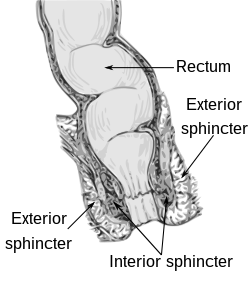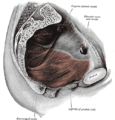Anal canal
This articleneeds additional citations forverification.(December 2018) |
| Anal canal | |
|---|---|
 Anatomy of the anus and rectum | |
 Coronal section through the anal canal. B. Cavity ofurinary bladderV.D.Ductus deferens.S.V.Seminal vesicle.R. Second part ofrectum.A.C. Anal canal. L.A.Levator ani.I.S.Sphincter ani internus.E.S.Sphincter ani externus. | |
| Details | |
| Precursor | Hindgut,proctodeum |
| Artery | Superior rectal artery(abovepectinate line) andinferior rectal artery(below line) |
| Vein | Superior rectal vein(above pectinate line) andInferior rectal vein(below line) |
| Nerve | Autonomicinferior hypogastric plexus(above pectinate line) andsomaticinferior rectal nerves(below line) |
| Lymph | Superficial inguinal lymph node(below pectinate line) andinternal iliac lymph nodes(above line) |
| Identifiers | |
| Latin | canalis analis |
| MeSH | D001003 |
| TA98 | A05.7.05.001 |
| TA2 | 3009 |
| FMA | 15703 |
| Anatomical terminology | |
Theanal canalis the part that connects therectumto theanus,located below the level of thepelvic diaphragm.[1]It is located within theanal triangleof theperineum,between the right and leftischioanal fossa.As the final functional segment of thebowel,it functions to regulate release ofexcrementby two muscularsphinctercomplexes. The anus is the aperture at the terminal portion of the anal canal.
Structure
[edit]In humans, the anal canal is approximately 2.5 to 4 cm (0.98 to 1.57 in) long, from the anorectal junction to theanus.[2][3][4]It is directed downwards and backwards. It is surrounded by inner involuntary and outer voluntary sphincters which keep thelumenclosed in the form of an anteroposterior slit.
The canal is differentiated from the rectum by a transition along the internal surface fromendodermalto skin-likeectodermaltissue.
The anal canal is traditionally divided into two segments, upper and lower, separated by thepectinate line(also known as the dentate line):
- upper zone (zona columnaris)
- mucosa is lined bysimple columnar epithelium
- features longitudinal folds or elevations of tunica mucosa which are joined inferiorly by folds ofmucous membraneknown asanal valves
- supplied by thesuperior rectal artery(a branch of theinferior mesenteric artery)
- lower zone
- divided into two smaller zones, separated by a white line known as theHilton's line:
- zona hemorrhagica - lined bystratified squamous non-keratinized epithelium
- zona cutanea - linedstratified squamous keratinized epithelium,which blends with the surrounding perianal skin
- supplied by theinferior rectal artery(a branch of theinternal pudendal artery)
- divided into two smaller zones, separated by a white line known as theHilton's line:
Theanal vergerefers to thedistalend of the anal canal, a transitional zone between theepitheliumof the anal canal and theperianal skin.It should not be confused with the pectinate line between the upper and lower zones within the anal canal.
Theanal glandsecretes lymphal discharge and built-upfecal matterfrom thecolonlining. In some animals this gland expungement can be done routinely every 24–36 months to prevent infection andfistulaformation.
Relations
[edit]- Theischioanal fossaare on each side of the anal canal.
- Theperianal spacesurrounds the anal canal below the white line.
- The submucous space of the canal lies above the white line between the mucous membrane andinternal anal sphincter muscle.
Function
[edit]Theexternal anal sphinctermuscle is the voluntary muscle that surrounds and adheres to the anus at the lower margin of the anal canal. This muscle is in a state oftonic contraction,but duringdefecation,it relaxes to allow the release offeces.
Movement of the feces is also controlled by the involuntarily controlled internal anal sphincter, which is an extension of the circular muscle surrounding the anal canal. It relaxes to expel feces from the rectum and anal canal.
Additional images
[edit]-
Anatomy of the anus and rectum
-
Left levator ani from within
-
The interior of the anal canal and lower part of the rectum
-
Median sagittal section of male pelvis
-
Median sagittal section of female pelvis
See also
[edit]References
[edit]- ^Madoff, Robert D.; Melton-Meax, Genevieve B. (2020)."136. Diseases of the rectum and anus".In Goldman, Lee; Schafer, Andrew I. (eds.).Goldman-Cecil Medicine.Vol. 1 (26th ed.). Philadelphia: Elsevier. p. 933.ISBN978-0-323-55087-1.
- ^"Anal canal".
- ^Anal+Canalat the U.S. National Library of MedicineMedical Subject Headings(MeSH)
- ^"Anal Canal - Location, Function and Pictures".
External links
[edit]- Pelvisat The Anatomy Lesson by Wesley Norman (Georgetown University)
- Anatomy figure: 44:05-00at Human Anatomy Online, SUNY Downstate Medical Center — "The rectum and anal canal in the male pelvis"





